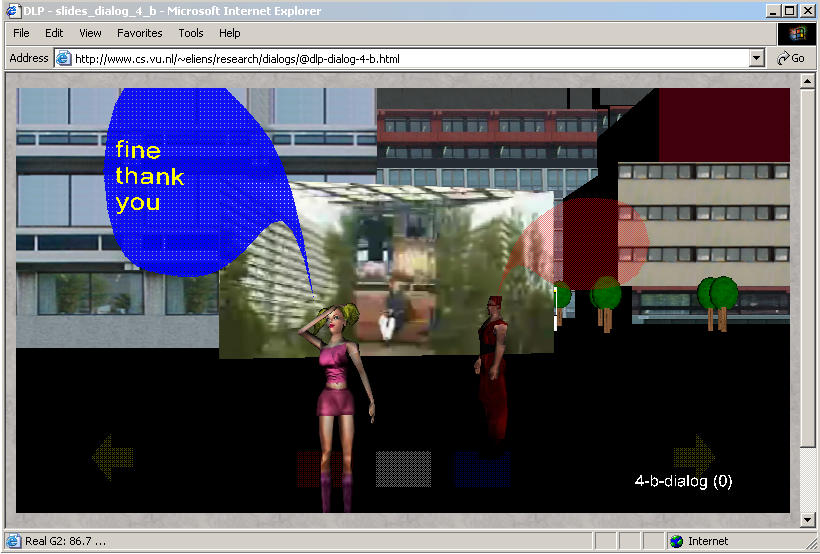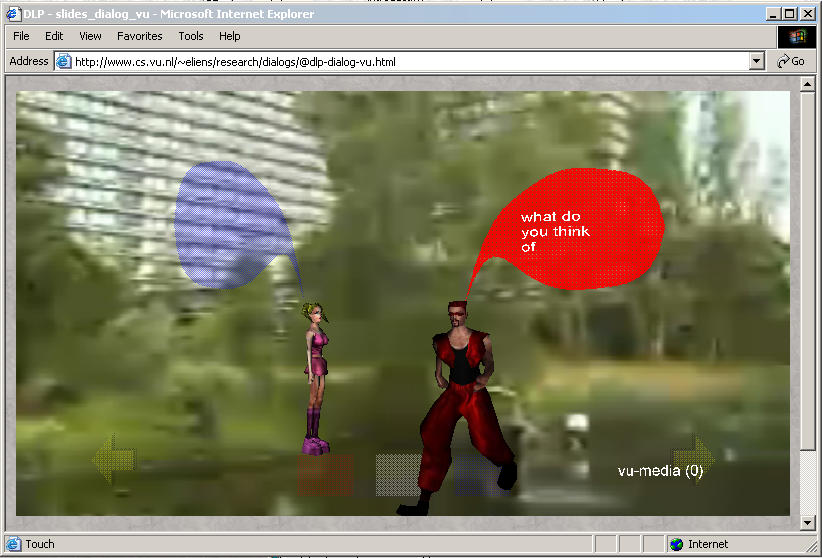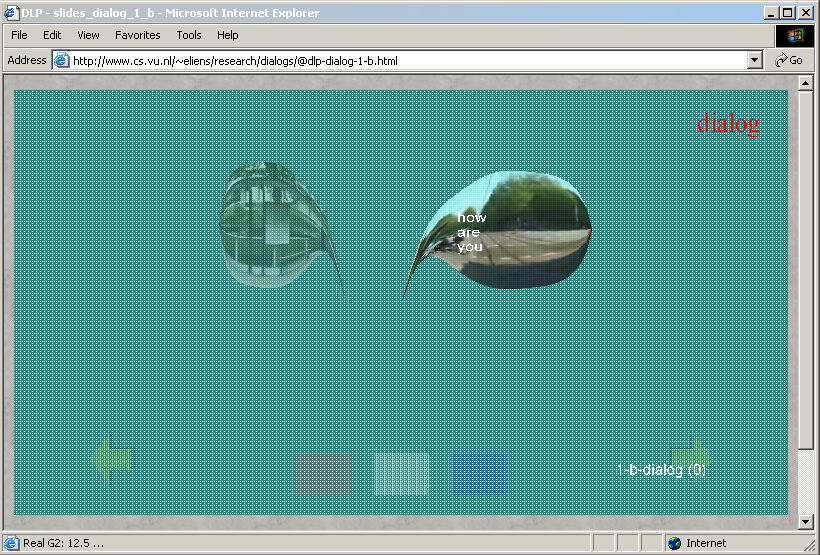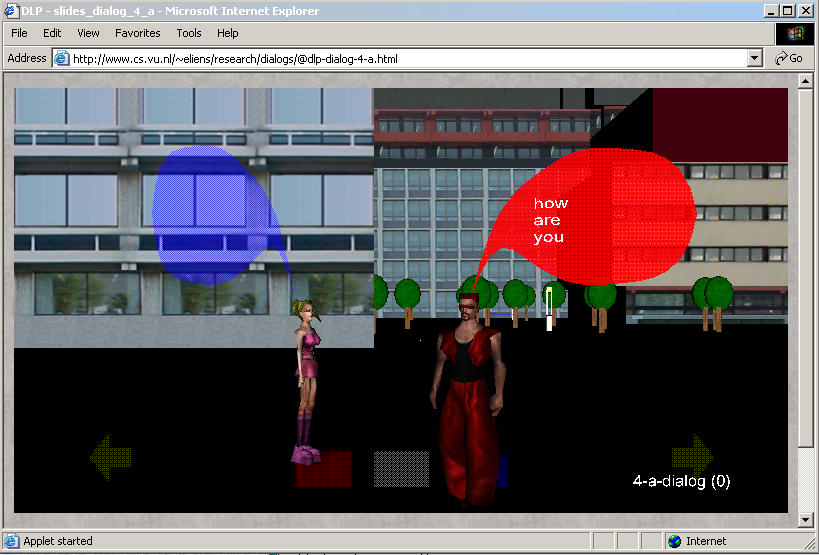topical media & game development




PDF
A framework for mixed media -- emotive dialogs, rich media and virtual environments
Anton Eliëns, Claire Dormann,
Zhisheng Huang and Cees Visser
Keywords: presentation technology, persuasion, mixed media, dialogs, virtual worlds, rich media.
paper
abstract
We present a framework for merging mixed media in a unified fashion.
Our framework supports 3D virtual environments,
rich media (such as digital video) and (emotive) dialogs presented
by humanoid characters or simply text balloons.
We speak of mixed media since each of these media
may have a clearly distinct narrative structure.
In this paper, we will discuss the background and
motivation of our approach, which is the presentation
of instructional material using (rich media) 3D slides,
enhanced with (possibly ironic) comments presented
by humanoid characters.
And, we will explore the design space of
such mixed media presentations, that is the
issues involved in merging material with potentially
conflicting narrative structures.
In addition, we will look at the style parameters needed
to author such presentations in an effective way,
and we will briefly describe the implementation platform
used to realize the presentations.
Keywords and phrases:
presentation technology, persuasion, mixed media, dialogs, virtual worlds, rich media
Introduction
Some phenomena in the media are older than is generally recognized.
As observed in [Briggs and Burke (2001)],
some of the conventions of the 20th century comic books draw
directly or indirectly on an even longer visual tradition:
speech balloons
can be found in the eighteenth century prints, which are in turn an adaptation of the 'text scrolls'
coming from the mouths of the Virgin and other figures in medieval religious art.
In other words, mixed media have their origin in the medieval era,
where both visual material and textual material were part of the rethorics of
institutionalized religion.
Our interest in mixed media, that is the use of
speech ballons with text together with rich media
and 3D virtual environments, stems from developing
instructional material using 3D technology.
We enhanced the material, which was organized in sequentially
ordered slides, with comments presented by humanoid characters.
These comments would sometimes contain additional information,
and were sometimes plainly ironic, anticipating on students' comments.
Obviously, the dialogs were meant to draw the attention
to particular aspects, and more generally to increase the emotional
involvement of the students with the material.
Experimenting with the way comments could be added to
a slide, we found that the humanoids were often not necessary.
Also, to avoid interference with the material presented in the
slides, it was often necessary to place the speech ballons
somewhat off-center, for example in the lower right corner.
In this paper, we explore the design space of mixed media presentations,
which involve the juxtaposition of emotive dialogs,
rich media such as digital video and virtual environments.
We will discuss the issues involved in merging material
with distinct, potentially conflicting, narrative structures,
and we will look at the style parameters needed
to author mixed media presentations in an effective way.
Structure
The structure of the paper is as follows.
In section 2, we will briefly present
the background and motivation to our approach, with an example.
In section 3, we will discuss narrative
structure from the perspective of persuasion and emotional
involvement and compare our approach to related work.
In section 4, we will explore the design space of mixed
media and study a variety of combinations
at the hand of representative examples.
In section 5, we will look at the authoring issues
and discuss the style parameters we used.
In section 6, a brief description is given of
the implementation platform and in section 7 we will discuss
research directions and open issues.
Desktop VR is an excellent medium for presenting information,
for example in class, in particular when rich media
or 3D content is involved.
At VU, we have been using presentational VR
for quite some time,
in a course on
Web3D technology and also in our introduction multimedia
course.
Recently we included dialogs
using speech balloons (and possibly avatars) to display the text
commenting on a particular presentation.
A dialog is (simply) a sequence of phrases for two (virtual)
speakers. Each speaker, alternately, may deliver a phrase.
When delivering a phrase the speaker may step forward,
dependent on the style of presentation chosen.
The dialog text (and avatars) are programmed as
annotations to a particular scene as described in more
detail in section [authoring].
Each presentation is organized as a sequence of slides,
and dependent on the slides (or level within the slide)
a dialog may be selected and displayed.
See the appendix for a description of the slides format.
To be more precise, when the presenter goes to another
slide an observer object checks whether
there is a dialog available, and if so the dialog is started.
See section [platform], discussing the platform used for realizing the presentations.
example -- promotion video in virtual environment
In this example, we used a promotion video produced to attract
students to our university.
In figure (a) the promotion video is embedded in a virtual
environment of our university campus.
In figure (b) only the video is shown.
The dialog used
is, in both examples, a somewhat ironic comment on the contents of
the movie displayed.
In figure (a), you see the left avatar (named cutie) step forward
and deliver her phrase. This dialog continues until cutie remarks that she always wanted to be an agent.
In figure (b), you see the right avatar (named red)
step forward asking what do you think of
to discuss what it takes to be a student.
Note that in example (a) the avatars are more or less
natural inhabitants of the virtual environment,
whereas in example (b) they are just lain on top of the movie.
In the latter case, the positioning of the avatars
may easily seem unnatural, although it sometimes works
out surprisingly well.
\mbox{}\hspace{-0.8cm}
\hspace{-0.2cm}

|
\hspace{-0.7cm}

|
| (a) dialog in context | (b) dialog on video |
General perspectives -- narrative structure and persuasion
Mixed media, that is the combination of dialogs
with rich media and virtual environments,
may endanger the narrative structure of a presentation.
Each of these media entities may have a distinct narrative structure.
Slides are sequentially organized, and each slide may have levels
that are displayed in a sequential fashion.
The narrative structure of digital video may be
arbitrarily complex, and may make full use
of cinematographic rethorics.
Navigation and interaction in virtual environments
may be seen as a weak narrative structure, which may however
be strengthened by guided tours or viewpoint transformations,
taking the user to a variety of viewpoints
in a controlled manner.
Finally, dialogs have a well-defined temporal structure,
with alternating turns for the two (virtual) speakers.
In the following we will compare our approach to
Related research and investigate what possible advantages
we may obtain from mixed media presentations.
consonant or dissonant comments
Our approach is clearly reminiscent to the notorious
Agneta & Frida
characters developed in the Persona project.
The Persona project aims at:
investigating a new approach to navigation through information spaces,
Based on a personalised and social navigational paradigm, [Munro et al. (1999)].
The novel idea pursued in this project is to have agents (Agneta and
Frieda) that are not helpful, but instead just give comments, sometimes
with humor, but sometimes ironic or even sarcastic comments on the
user's activities, in particular navigating an information space or
(plain) web browsing.
In contrast with the Personas project, our (dialog) comments are part of a presentation which of itself has a definite narrative structure, in opposition to the 'random' navigation that occurs by browsing 'information spaces'.
As a consequence, our comments may be designed
taking the expected reaction of the audience
into consideration.
An interesting question is whether comments should be consonant
with the information presented (drawing attention to perticular aspects)
or dissonant (as with ironic or sarcastic comments).
engagement versus immersion
The characters and dialog text may be used to enliven the material.
In this way, the students' engagement with the material may be increased, [Engagement].
Clearly, there is a tension between engagement and immersion.
Immersion, understood as the absorption within a familiar
narrative scheme (in our case the lecturer's presentation),
may be disrupted by the presence of (possibly annoying)
comments, whereas the same comments may lead the attention
back to the material, or
provide a foothold for affective reactions to the material,
[Dijkstra et al. (1994)].
Also, the audience might start to anticipate the occurrence
of a dialog and possibly identify themselves with one
of the characters.
emotional enhancement
In one of her talks, Kristina Höök observed that some users get really fed up with the comments delivered by Agneta and Frieda. Nevertheless, it also appeared that annoyance and irritation increased the emotional involvement with the task.
For our presentations, we may ask how mixed media may help in increasing the emotional involvement of the audience or, phrased differently, how dialogs may lead to emotional enhancement of the material, [Astleneir (2000)].
An important difference with the Personas project is that our platform supports the actual merge of dialogs and the humanoid characters that deliver them in a unified presentation format, that is a rich media 3D graphics format based on X3D/VRML.
As a consequence, the tension between immersion and engagement may be partially resolved, since the characters delivering the dialog may be placed in
their 'natural' context, that is a virtual environment
as in example (a).
Design space -- the juxtaposition of mixed media
In this section, we will explore in a more
systematic way what options we have in creating
mixed media presentations.
We have a division according to levels of complexity,
with at level 0 the basic material, that is dialog
text, rich media objects such as digital video
and virtual environments.
The other levels arise by adding dialogs to either
the media object or the virtual environment.
We also allow for the virtual speakers of the dialog
to change attributes of the presentation, for example
by depositing objects in the (virtual) environment,
In summary, we distinguish between the following levels of complexity:
levels of complexity

The ordering of these levels is not unique, but admittedly depends
on our intuition of complexity.
For each of these levels we have a collection
of representative examples.
\mbox{}\hspace{-0.8cm}
\hspace{-0.2cm}

|
\hspace{-0.7cm}

|
| (c) context in dialog | (d) dialog in context |
level 0: basic material

level 1 -- combined:

When combining the media object with the dialog,
we may simply superpose the dialog on the movie,
in a similar way as shown in figure (b), or we may
project the video onto the surface of the speech balloon,
as illustrated in figure (c), which has a rather surprising effect.
level 2 -- with avatars:

It makes quite a difference whether humanoid characters are used
to deliver the dialog or only the plain text balloons.
The use of avatars seems to enhance the recognition of
a particular role, that is the kind of comments the character makes.
Once the role is established, the avatars may dissappear
and the (color and position) of the speech ballons suffice.
Another difference is that the ballons should be positioned
differently without the presence of an avatar.
level 3 -- with attributes

Apart from speaking their dialog text,
the avatars may undertake autonomous actions.
They might get bored and display ambient behavior, like looking on
their watch.
In addition, before or after speaking their phrase, they
may change their position and modify the environment,
for example by depositing (3D) objects to illustrate
their comments.
These actions may be arbitrarily complex, and for example
result in going to the next (level of the) slide.
level 4 -- with context:

The ultimate context of a slide may be a virtual environment,
as in our examples (a) and (d) a virtual environment of our university campus developed by one of our students.
Having such a context, the difference between
a presentation and an information space becomes blurry
since the user may interact with the environment and, for example,
start a guided tour.
In such cases the developer must decide whether
the dialog takes place in a fixed
position of the virtual environment or is fixed relative
to the viewpoint of the user/audience.
Merging the dialogs with the virtual environment and
the media object might, by the way, lead to
overly complex presentations such as the one depicted in figure (a).
Authoring issues -- style parameters
In the next two sections, we will look at the implementation
of the dialogs, respectively from an authoring perspective
and a system perspective.
The authoring of a dialog for a particular dialog or slide
should be easy.
The encoding of the dialog used in the examples discussed
is illustrated below.
dialog
<phrase right="how~are~you"/>
<phrase left="fine~thank~you"/>
<phrase right="what do~you think~of studying ..."/>
...
<phrase left="So,~what~are you?"/>
<phrase right="an ~agent" style="[a(e)=1]"/>
<phrase left="I always~wanted to be~an agent" style="[a(e)=1]"/>

The phrases are (textually) included in a slide,
which is itself indicated by appropriate begin and end tags.
The alternation between speakers is indicated by the
attributes left and right.
Although detailed indications of (among others)
when a phrase should be uttered are possible, these
advanced options are hardly ever used, except for
defining complex actions.
Furthermore, there are a number of style parameters
that may be used to decide for example
whether the avatars or persona are visible, where to place
the dialogs balloons on the display, as well as the color
and transparancy of the balloons.
To this end, we have included a style attribute
in the phrase tag, to allow for setting
any of the style parameters.
style parameters
<phrase right="red" style="[p=(0.5,0,0),persona=0,balloon=0]"/>
<phrase left="cutie" style="[p=(-0.5,0,0),persona=0,balloon=0]"/>
<gesture right=1 style=default/>
<gesture left=1 style=default/>

Apart from phrases, we also allow for gestures, taken from
the built-in repertoire of the avatars.
In [Huang et al. (2003)], we discuss how to extend the repertoire
of gestures, using a gesture specification language.
Both phrases and gestures are compiled into DLP code
and loaded when the annotated version of the presentation VR
is started. See section [platform].
Implementation -- the DLP+X3D platform
In our group we have developed a platform
for intelligent multimedia,
that is a platform
for virtual environments based on agent technology,
supporting embodied conversational agents, [Eliens et al. (2002)].
Our platform merges X3D/VRML
with the distributed logic programming language DLP.
To effect an interaction between the 3D content
and the behavioral component written in DLP,
we need to deal with control points,
and (asynchronous) event-handling.
DLP+X3D
- control points: get/set -- position, rotation, viewpoint
- event-handling -- asynchronous accept

The control points are actually nodes in the VRML scenegraph
that act as handles which may be used to manipulate the scenegraph.
Our approach also allows for changes in the scene that
are not a direct result of setting attributes
from the logic component, as for example
the transition to a new slide.
An event observer is actually used
to detect
the transition to another slide.
A dialog may then be started to comment on
the contents of that particular slide.
The DLP+X3D platform may also be used
to realize multi-user virtual environments, [Huang et al. (2002)].
About how a multi-user environment might be used
to explore narrative structures, we can only speculate!
Research directions -- conversational agents
In the examples discussed, the agent avatars entered
a dialog with one another to comment on a particular scene or slide,
to augment a presentation.
As a next step, we would like to extend our approach
to allow for interaction in a virtual
environment, that is to augment information spaces.
virtual musea
As an example,
for a virtual gallery for Escher, we can use dialogs to enhance visitors understanding and
enjoyment of the work of Escher on display. We can increase viewers' involvement by directing their attention to
salient features of the painting or the exhibition. By giving information on the ideas that motivate the painting, its
creation or the life of Escher, we can draw viewers more effectively into the world of Escher.
In addition, conversational agents can assist
the user in finding a particular work and,
in particular for the 'impossible spaces' of Escher,
offer means to
experiment with the graphical attributes of the world.
cultural heritage
Another application where we can profit
from the rich presentation facilities of desktop VR
is the construction of a virtual environment for
cultural heritage.
As an example, think of the database of
INCCA
(International Network for the Conservation of Contemporary Art),
which contains interviews (auditory material), photos and drawings
(images),
and documents and other written material.
We could well imagine to have (conversational) presentation agents
to present the information to the user.
Dialogs may be used to present various viewpoints
on a particular oeuvre.
Conclusions
We have described a framework for mixed media that allows for the superposition of (text) dialogs delivered by humanoid avatars and/or speech balloons, on arbitrary rich media objects and virtual environments.
We have looked at the design space of mixed media presentations, by discussing a number of representative examples, each illustrating a particular level of complexity. Also authoring issues were discussed, and an indication was given of the style parameters needed to develop effective presentations.
We have further described the implementation platform used to realize the mixed media presentations and explored what new applications and extensions are feasible.
Appendix: The slides format
In this technical appendix, a simplified description will be
given of the slides format.
Slides are fragments of a document that may be presented to an audience.
Our approach allows for displaying slides in either
dynamic HTML or VRML.
Slides are encoded using XML.
slides in XML
<document>
...
<slide id="1">
<text>
<line>What about the slide format?</line>
<break/>
<line>yeh, what about it"?</line>
</text>
<vrml>Sphere { radius 0.5 }</vrml>
</slide>
...
<slide id="2">
<vrml>Sphere { radius 0.5 }</vrml>
</slide>
...
</document>

The first slide contains some text and a 3D object.
The second slide contains only a 3D object.
Inbetween the slides there may be arbitrary text.
The slides are converted to VRML using XSLT,
the XML transformation language.
VRML PROTOs
To support slides in VRML a small collection
of PROTO definitions is used.
protos
- slideset -- container for slides
- slide -- container for text and objects
- slide -- container for lines of text
- line -- container for text
- break -- empty text

The slides contained in a document constitute a slide set.
A slide set is a collection of slides that may contain lines of text
and possibly 3D objects.
For displaying 3D objects in a slide
we need no specific PROTO.
The slide PROTO defines an interface which may be used
to perform spatial transformations on the slide,
like translation, rotation and scaling.
The interface also includes a field to declare the
content of the slide, that is text or (arbitrary) 3D objects.
The slideset contains a collection of slides, and allows
for proceeding to the next slide.
A text may contain a sequence of lines and breaks.
It supports a simple layout algorithm.
annotated slides
Slides may be annotated with dialogs,
as described in section 5.
The annotation is compiled to DLP code,
which is activated whenever the slide (or level within a slide)
to which the annotation belongs is displayed.
To intercept the occurrence of a particular event,
such as the display of a slide, we use an observer
object which is specified as in the code fragment below.
observer
:- object observer : [actions].
var slide = anonymous, level = 0, projector = nil.
observer(X) :-
projector := X,
repeat,
accept( id, level, update, touched),
fail.
id(V) :- slide := V.
level(V) :- level := V.
touched(V) :- projectortouched(V).
update(V) :- act(V,slide,level).
:- end_object observer.
The observer object
has knowledge of, that is inherits from, an object
that contains particular actions.
As indicated before, events come from the 3D scene.
For example, the touched event results from mouse clicks
on a particular object in the scene.
On accepting an event, the corresponding method or clause
is activated, resulting in either changing the value
of a non-logical instance variable,
invoking a method,
or delegating the call to another object.
(C) Æliens
27/08/2009
You may not copy or print any of this material without explicit permission of the author or the publisher.
In case of other copyright issues, contact the author.


![]()


![]()
![]()
![]()
![]()
![]()
![]()
![]()
![]()
![]()
![]()
![]()